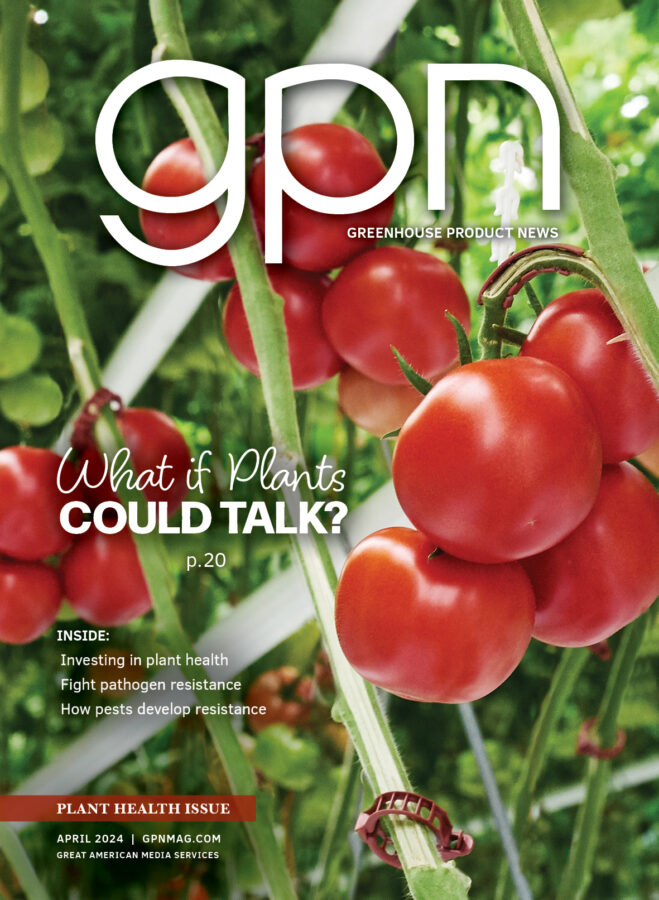What Really Causes Stretch?
Does ammoniacal nitrogen cause stretch in plants, or conversely, does the alternative nitrogen source, nitrate, cause compactness? What does your experience indicate? Do you have all of the facts?
Because the application of high-nitrate fertilizers oftenresults in compact plants, growers’ experiences seem to confirm that highnitrate fertilizers result in compact plants. But we need to take a look atwhat their fertilizer is composed of before making this decision.
A Little Background
Fertilizers with a high proportion of nitrogen in thenitrate form include 13-2-13, 15-0-15, 14-0-14 and 17-0-17. The percentages ofnitrogen in the nitrate form in these fertilizers are 11, 13, 8 and 20 percent,respectively. Growers who formulate their own fertilizer most often make a15-0-15 fertilizer when they want compact plants. They do this by combiningcalcium nitrate and potassium nitrate in a 2:1 weight ratio. A typical formulawould be as follows: 6 oz of calcium nitrate plus 3 oz of potassium nitratesuspended in 100 gallons of water yields a concentration of 100 ppm nitrogen.
When applied, this formulation will indeed result in compactplants; therefore, it would be easy to conclude that the nitrate form ofnitrogen contained in this formula is the cause of the resultant compactplants. One could also then conclude that the converse of this formula must betrue, namely that ammoniacal nitrogen causes stretch. In fact, growers oftendraw this conclusion about ammoniacal nitrogen because they use theabove-mentioned, high-nitrate fertilizers to produce compact plants and becausewhen they want more luxuriant growth, they use fertilizers with one-third ormore of their Á nitrogen in the ammoniacal and urea forms. Formulationswith high concentrations of ammoniacal nitrogen include 20-10-20 and 15-16-17.
This conclusion is, however, quite inaccurate because thereis a confounding factor involved that has not been considered. Each of thehigh-nitrate fertilizers is low in or missing a key component for vigorousgrowth phosphate. Unless we understand how each component in thefertilizer, or left out of the fertilizer, affects the plants, we can notaccurately attribute the results to any one component. Thus, what we should beasking is if a high-nitrate proportion or a low phosphate level causes plantcompactness in the above-referenced, high-nitrate fertilizers?
Throughout the years, we have formulated an extensive rangeof nutrient combinations in our nutritional research program at North CarolinaState University. Our results from experimenting with these formulations havenot indicated any relationship between form of nitrogen and rate of growth. Toresolve this disparity between grower practice and research observation, weconducted the following experiments.
Experiments
We recently conducted four experiments that shed light onthis phosphate/nitrate question.
Experiment #1. In the first experiment, plug seedlings of impatiens, marigold and tomato were produced receiving a series of nutrientsolutions, all containing 91 ppm each of nitrogen and potassium (K2O) butdifferent amounts of phosphorus (P). Phosphorus levels used were 2, 4, 6 and 20ppm. The responses from all three plants were similar and are typified by thetomato plants shown on page 24. Although each fertilizer contained the sameratio of 60 percent nitrate to 40 percent ammonium proportion of nitrogen,growth was very different in each treatment. The results of the firstexperiment can be summarized as follows: plant size increased with increasing phosphorus concentrations.
Experiment #2. In the second experiment, several fertilizerformulations varying in phosphorous content and proportion of nitrate forammonium were applied to impatiens, gomphrena and petunia plug seedlings. Thelevel of phosphorous in each plant shoot was then measured. The relationshipbetween plant height and concentration of phosphorous taken up into the plantshoots can be seen in the graph on page 26. The results show that height in thefour plants increased with increasing phosphorus concentration in the shoottissue. The results were surprising because the general consensus amongnutritionists has been that phosphorous could only provide a certain degree ofstimulus, after which growth would level off. The consensus has been thatgrowth increases would occur up to a tissue phosphorus concentration of about0.25 percent of dry matter and then level off, regardless of higher phosphorusconcentrations. In this study, growth increased up to tissue phosphorusconcentrations of 0.8-1.0 percent. Clearly, phosphorus supply is a strongerdriving force behind the growth ofyoung plants than has formerly been realized.
Experiment #3. In our third experiment, we formulatedvarious series of fertilizer treatments and applied them to seedlings ofgomphrena, impatiens, marigold, petunia and tomato. In the first series, allfertilizers contained 100 ppm nitrogen and potassium (K2O) and 50 ppm (P2O5)phosphate. The percentages of nitrogen in the ammonium form in these treatmentswere 40, 13, 7 and 0. The results with gomphrena are typical of all crops andare shown in the top picture on page 28. Growth of all plants was similar. Thefertilizers we used in the study ranged from a low-nitrate fertilizer, with 40percent ammonium and 60 percent nitrate similar to 20-10-20, to a high-nitratefertilizer, with 100 percent nitrate and no ammonium. This first series offertilizers showed that form of nitrogen had no effect on growth.
A second series of fertilizers in this experiment had afixed nitrogen proportion of 60 percent nitrate to 40 percent ammonium butvaried in phosphate concentration, with levels of 50, 15, 7.5 and 0 ppm (P2O5).With this series, as in the first experiment, plant size increased withincreasing phosphate concentration.
Experiment #4. We conducted the fourth experiment to see if something about the self-mixed fertilizer was affecting plant growth. In thisexperiment, a 15-0-15 commercial fertilizer was applied to seedlings ofgomphrena, impatiens, marigold, petunia and tomato. Our results are representedby the marigold plants in the bottom picture on page 28. Plants that receivedthe 15-0-15 fertilizer alone were compact. Plants that received the 15-0-15fertilizer plus sufficient monobasic calcium phosphate to yield the equivalentto a 15-7.5-15 fertilizer were larger, indicating that in both self-mixedfertilizers and in commercial fertilizers the phosphorous component isnecessary for full, luxuriant plant growth. Á
Conclusions
When all of these results are put together, it is clear thatthe form of nitrogen did not govern plant size. Repeatedly, the differences inplant growth were a consequence of the amount of phosphorus supplied to theplants, not the form of nitrogen. Going back to the original question,”Does ammonium-nitrogen really cause plant stretch,” the answerwould have to be no. Differences in plant height among the many fertilizersvarying in ammonium-nitrate proportion are controlled by the phosphate low phosphate levels result in compact plants, high phosphate levels result intall plants.
Fertilizers with high proportions of their nitrogen in thenitrate form typically contain little or no phosphate, resulting in compactplants and leading to the incorrect assumption that nitrate nitrogen causescompactness. Fertilizers with high proportions of nitrogen in the ammonium form(33 percent or more) invariably contain high levels of phosphate. Thesefertilizers yield the more luxuriant growth to which we are accustomed andresult in the belief that ammoniacal nitrogen causes stretch.
Thus, if compact plants are your goal, you should limit theamount of phosphorus applied to the plants; conversely, if full plants are yourgoal, you should apply fertilizers containing the appropriate levels ofphosphorus.
The authors wish to thank The Fred C. Gloeckner Foundation,Inc. for financial support of this study, Ball Seed Co. for providing the seedsused in this study and Nancy C. Mingis for analysis of substrate and tissuesamples.


 Video Library
Video Library 




















